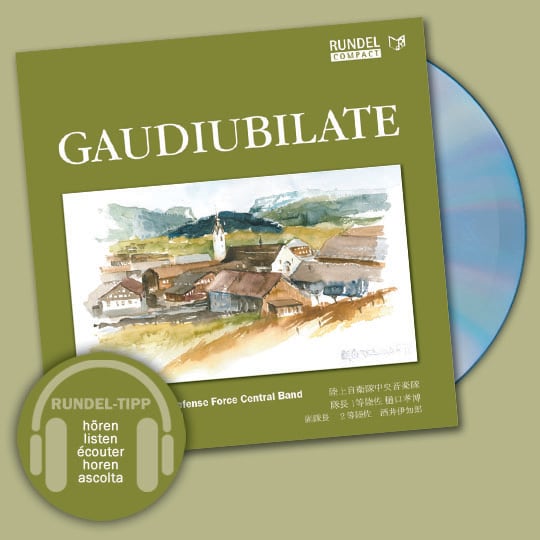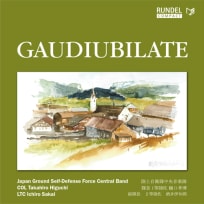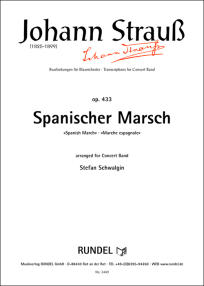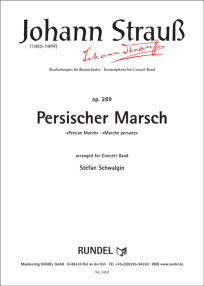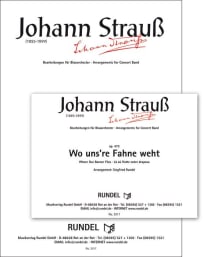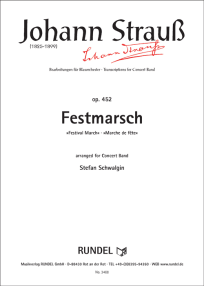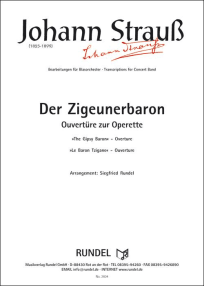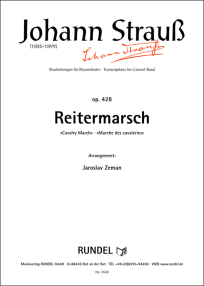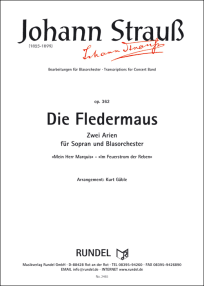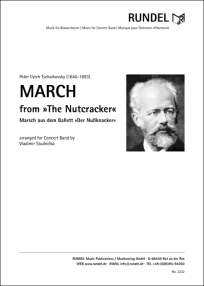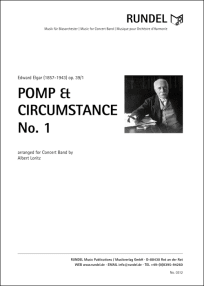Concert Band
Spanischer Marsch
op. 433
Spanish March · Marche espagnole

Concert Band
Spanischer Marsch
op. 433
Spanish March · Marche espagnole
Composer
Arranger
Performance time
00:05:20
Grade Level
Oberstufe
Publisher
Rundel
Size
A4
Info
Full Score + Condensed Score + Parts
Order Number
MVSR3449
Release Date
2023
Info
Johann Strauss II, best known as the “Waltz King”, also composed a few marches. He dedicated a whole series of pieces of this genre to certain countries and their monarchs: the “Persian March op. 289” (1864), the “Egyptian March op. 335” (1869), the “Russian March op. 426” (1886) and finally the “Spanish March op. 433” (1888). The latter was dedicated to the regent of Spain, María Cristina (1858-1929).
The “Spanish March” was composed on the occasion of a planned concert tour of the composer through Spain, which then was canceled. Strauss, who didn’t like long journeys, preferred to avoid the long trip and instead sent his musical greetings to Madrid. As a “reward”, María Cristina awarded the composer the Grand Cross of the Order of Isabella. The work was first performed in Vienna on October 21, 1888, conducted by his brother, Eduard Strauss.
It is a long, dramatic and artistically crafted march, which spreads typical “Spanish” color in terms of melody and shape, even though the themes all come from Strauss himself. After a dignified introductory fanfare, small formal parts alternate with each other, which on the one hand have a folkloric-dance and on the other hand a longing-elegiac character. The “Spanish” coloration becomes evident, among other things, through the use of the Spanish “national instrument”, the castanets. The march is often performed at the Vienna Philharmonic’s New Year’s Concert.
The “Spanish March” was composed on the occasion of a planned concert tour of the composer through Spain, which then was canceled. Strauss, who didn’t like long journeys, preferred to avoid the long trip and instead sent his musical greetings to Madrid. As a “reward”, María Cristina awarded the composer the Grand Cross of the Order of Isabella. The work was first performed in Vienna on October 21, 1888, conducted by his brother, Eduard Strauss.
It is a long, dramatic and artistically crafted march, which spreads typical “Spanish” color in terms of melody and shape, even though the themes all come from Strauss himself. After a dignified introductory fanfare, small formal parts alternate with each other, which on the one hand have a folkloric-dance and on the other hand a longing-elegiac character. The “Spanish” coloration becomes evident, among other things, through the use of the Spanish “national instrument”, the castanets. The march is often performed at the Vienna Philharmonic’s New Year’s Concert.
Keywords
Arrangement / Transcription
Casanets
Classical Music
Europe
Harp
March
New Year's Concert
New Year's Eve concert
Orchestral Transcriptions
Request Concert
RUNDEL Johann Strauss Edition
RUNDEL YouTube Channel
Spain
Viennese Classicism
Listen & read from the Rundel YouTube Channel
RUNDEL VIDEO
Spanischer Marsch
Notes available at:
https://www.rundel.de/en/
op. 433
Spanish March · Marche espagnole
Johann Strauss II, best known as the “Waltz King”, also composed a few marches. He dedicated a whole series of pieces of this genre to certain countries and their monarchs: the “Persian March op. 289” (1864), the “Egyptian March op. 335” (1869), the “Russian March op. 426” (1886) and finally the “Spanish March op. 433” (1888). The latter was dedicated to the regent of Spain, María Cristina (1858-1929).
The “Spanish March” was composed on the occasion of a planned concert tour of the composer through Spain, which then was canceled. Strauss, who didn’t like long journeys, preferred to avoid the long trip and instead sent his musical greetings to Madrid. As a “reward”, María Cristina awarded the composer the Grand Cross of the Order of Isabella. The work was first performed...
https://www.rundel.de/en/
op. 433
Spanish March · Marche espagnole
Johann Strauss II, best known as the “Waltz King”, also composed a few marches. He dedicated a whole series of pieces of this genre to certain countries and their monarchs: the “Persian March op. 289” (1864), the “Egyptian March op. 335” (1869), the “Russian March op. 426” (1886) and finally the “Spanish March op. 433” (1888). The latter was dedicated to the regent of Spain, María Cristina (1858-1929).
The “Spanish March” was composed on the occasion of a planned concert tour of the composer through Spain, which then was canceled. Strauss, who didn’t like long journeys, preferred to avoid the long trip and instead sent his musical greetings to Madrid. As a “reward”, María Cristina awarded the composer the Grand Cross of the Order of Isabella. The work was first performed...


